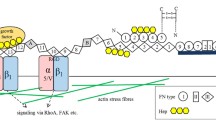Abstract
We have previously shown that the recombinant human fibronectin (FN) fragment composed of central cell binding domains (CCBD) spanning the ninth and tenth type III domains promotes cell adhesion and proliferation of osteoblasts. In the present study, we investigated the biological potency of heparin-binding domain (HBD) of FN spanning the twelfth and fourteenth type III domains. The HBD of FN significantly enhances the RGD-containing CCBD-mediated cell adhesion and proliferation in HOS cells (P < 0.05).
Similar content being viewed by others
References
Buck CA, Horwitz AF (1987) Cell surface receptors for extracellular matrix molecules. Annu Rev Cell Biol 3:179–205
Choung PH, Seo BM, Chung CP, Yamada KM, Jang JH (2002) Synergistic activity of fibronectin and fibroblast growth factor receptors on neuronal adhesion and neurite extension through extracellular signal-regulated kinase pathway. Biochem Biophys Res Commun 295:898–902
Gallagher JT, Lyon M, Steward WP (1986) Structure and function of heparan sulphate proteoglycans. Biochem J 236:313–325
Ingham KC, Brew SA, Atha DH (1990) Interaction of heparin with fibronectin and isolated fibronectin domains. Biochem J 272:605–611
Ku Y, Chung CP, Jang JH (2005) The effect of the surface modification of titanium using a recombinant fragment of fibronectin and vitronectin on cell behavior. Biomaterials 26:5153–5157
Miyamoto S, Teramoto H, Gutkind JS, Yamada KM (1996) Integrins can collaborate with growth factors for phosphorylation of receptor tyrosine kinases and MAP kinase activation: roles of integrin aggregation and occupancy of receptors. J Cell Biol 135:1633–1642
Peterson JA, Sheibani N, David G, Garcia-Pardo A, Peters DM (2005) Heparin II domain of fibronectin uses alpha4beta1 integrin to control focal adhesion and stress fiber formation, independent of syndecan-4. J Biol Chem 280:6915–6922
Ruoslahti E (1988) Fibronectin and its receptors. Annu Rev Biochem 57:375–413
Zhu X, Assoian RK (1995) Integrin-dependent activation of MAP kinase: a link to shape-dependent cell proliferation. Mol Biol Cell 6:273–282
Acknowledgement
This work was supported by BumSuk Academic Research Fund of 2005.
Author information
Authors and Affiliations
Corresponding author
Rights and permissions
About this article
Cite this article
Kim, JH., Park, SO., Jang, HJ. et al. Importance of the Heparin-binding Domain of Fibronectin for Enhancing Cell Adhesion Activity of the Recombinant Fibronectin. Biotechnol Lett 28, 1409–1413 (2006). https://doi.org/10.1007/s10529-006-9103-x
Received:
Accepted:
Published:
Issue Date:
DOI: https://doi.org/10.1007/s10529-006-9103-x




